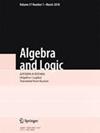对正常子组有限制的组
IF 0.6
3区 数学
Q4 LOGIC
引用次数: 0
摘要
证明了如果G是一个没有2阶元素的群,并且G的每一个2生成的子群的正规闭包是不超过3类的幂零群,则G将是不超过4类的幂零群。并证明了二阶元的限制是不能取消的。本文章由计算机程序翻译,如有差异,请以英文原文为准。
Groups with Restrictions on Normal Subgroups
It is proved that if G is a group without elements of order 2, and the normal closure of every 2-generated subgroup of G is a nilpotent group of class at most 3, then G will be a nilpotent group of class at most 4. It is also shown that the restriction on second-order elements cannot be lifted.
求助全文
通过发布文献求助,成功后即可免费获取论文全文。
去求助
来源期刊

Algebra and Logic
数学-数学
CiteScore
1.10
自引率
20.00%
发文量
26
审稿时长
>12 weeks
期刊介绍:
This bimonthly journal publishes results of the latest research in the areas of modern general algebra and of logic considered primarily from an algebraic viewpoint. The algebraic papers, constituting the major part of the contents, are concerned with studies in such fields as ordered, almost torsion-free, nilpotent, and metabelian groups; isomorphism rings; Lie algebras; Frattini subgroups; and clusters of algebras. In the area of logic, the periodical covers such topics as hierarchical sets, logical automata, and recursive functions.
Algebra and Logic is a translation of ALGEBRA I LOGIKA, a publication of the Siberian Fund for Algebra and Logic and the Institute of Mathematics of the Siberian Branch of the Russian Academy of Sciences.
All articles are peer-reviewed.
 求助内容:
求助内容: 应助结果提醒方式:
应助结果提醒方式:


